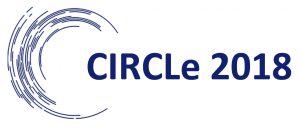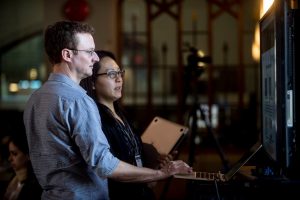Capturing and Reflecting the Learning Process through ePortfolios, 11:00 am to 12: 15 pm
To see all table discussion notes for this session, click here
Questions framing the presentations in Session 1:
- How can learning can be processed and represented using e-portfolios and online platforms?
- What do online platforms capture that other forms might not? What is problematic about using digital spaces for reflective practices?
- How can students use e-portfolios in more critical and reflexive ways?
- How should educators pedagogically distinguish between using e-portfolios as a tool for personal versus professional identity development?
- What are some best practices for documenting difficult, authentic, and complex learning experiences?
TABLE 3 DISCUSSION:
- Issue of mobility from an Indigenous perspective – Letitia suggested reading Wampum as Hypertext by Angela M Hass
- Discussion about the vulnerability of putting yourself out there; also the permanence of what is posted
Q: How do have students understand that what they might want to post now, may not be appropriate in a few years? How do we scaffold this?
- Tracy Penny Light asks students to write different versions of their story
- Different versions also shows students that their digital identity is constructed
Suggestion:
- Penny suggests that the university require that all students begin a portfolio and throughout their degree take a few more 1-credit courses to work on the portfolio as a frame to their degree/studies
In Geography the identity aspect is tricky, just given that we focus on really complex environmental issues
Q: How can we integrate digital literacy with what we teaching in our disciplines? So that you aren’t taking time away from teaching history by including a portfolio in your history class
- allow instructor to draw on their actual expertise
Networking ePortfolios: Integrating Technology with Learning and Connecting to the Real World, 1:30 pm to 2:45 pm
To see all table discussions for this session, click here
Questions framing the presentations in Session 2:
- How can educators encourage students to make connections between their academic work and life experiences?
- How might we better integrate e-portfolios in courses to improve student engagement?
- What kinds of projects get students to use the technology effectively, both during and after the course?
- What are the shared overlaps and differences between learning portfolios and career portfolios?
TABLE 3 DISCUSSION:
Certain schools/disciplines lend themselves better to e-portfolios
Q: How do we cultivate a folio culture?
- Incentivizing faculty and taking the burden out of the faculty’s hands
- Alignment across silos – harmonizing the language that we use
- Faculty need to model their own
Q: How do we make faculty more open to portfolio use?
- often they are not open to students’ creativity when they just want to make the different parts of the blog/portfolio
- It’s useful to hear from people like Tommy Lewis – it’s important for students to know what employers are looking for
- Arts program as developed some videos for students with feedback from employees
Q: What is the difference between a learning and a showcase portfolio? Which one works in what context?
- guiding students to make that shift
- Fred Cutler’s project – students use WordPress as a learning tool but then allows them to select certain pieces of work to upload to a showcase portfolio with a customized url
- In the health care sector e-portfolios are a way of teaching medical professionals how to showcase what they do, without talking about their patients (which some do)
Q: How can we help students cultivate a digital identity? How to behave when you’re a professional on social media?
- Some faculty as assuming that students have the response to this question because they have technical skills
Students want to know how what they are learning relates to the real world.
The portfolio gives you more control during the interview, because it’s there and gives you something to talk about.
Learning through Assessment and the Future of ePortfolios, 3:15 pm to 4:30 pm
To see all table discussion for this session, click here.
Questions framing the presentations in Session 3:
- What might institutional learning cultures (academic, universities, colleges) learn from e-portfolio cultures (professional careers, visual arts, performing arts) regarding approaches to assessment?
- What are best practices for creating ‘folio cultures’ for the future of education?
- What are the incentives, benefits and challenges for faculty, students and programs to use e-portfolios or personal web spaces?
- What can we do to get more value from these digital tools?
TABLE 3 DISCUSSION:
Points on Assessment from Tracy Penny Light:
- Context: where is the learning occurring?
- Stakeholders: who conducts the assessment? Who is interested in the results? How is assessment defined by all stakeholders?
- What is being assessed: Is learning the key focus? Who defines what constitutes evidence of learning?
- How is assessment happening: Is the ePortfolio the only source of evidence?
Comments from group discussion:
Q: How to balance a rigid structure like the EU language learning portfolio and a student-centered, open portfolio?
- Students select what they want to have assessed even though they are required to include certain pieces
Q: How can we use assessment to support learner autonomy? Do we showcase written drafts or narrate them, or only choose a showcase piece?
Suggestion:
- Make visible the courses where ePortfolio support / assignments are included – eg adding a letter to a course code the same way that SFU uses a W to signal writing-intensive courses (e.g. ENGL100P)

